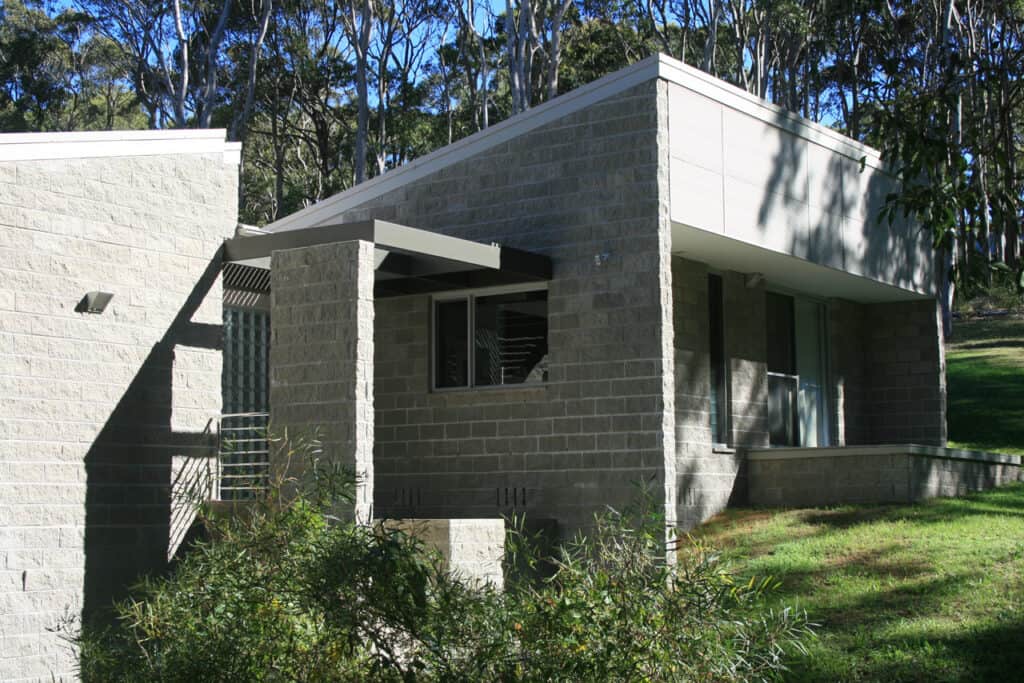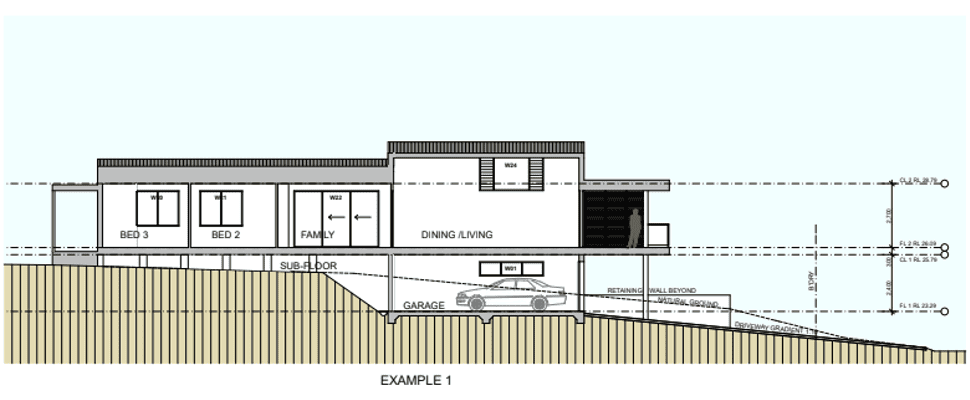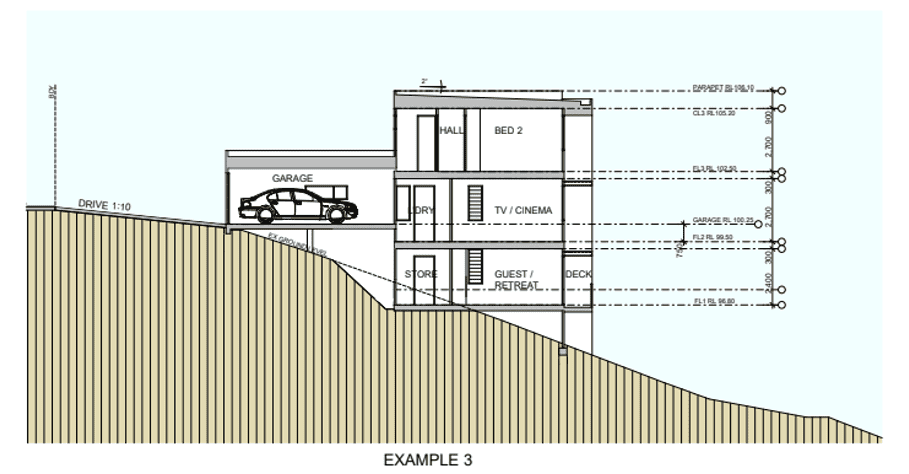Sloping blocks have a reputation for being difficult and expensive to build on. However, with the correct approach, a sloping block can offer unique opportunities that a level site can’t, and with the right expertise can be affordable and rewarding to build on.
The key to success with a sloping block is for the sloping site house designs to be specifically developed for the slope of the land rather than trying to adapt a building design that’s better suited to a flat site. Maximise your site with a home that’s purpose-built from expert steep block home designs prepared by an experienced Architect.
Why are sloping blocks traditionally considered difficult to work with?
Sloping blocks have received some bad press over the years – this is primarily due to the costs that can be involved in excavation and the construction of retaining walls to form a level building platform.
These costs can be increased when the excavation abuts side boundaries requiring extensive retaining walls along said boundaries. Excavating into the ground also complicates other building issues such as stormwater drainage, groundwater run-off, erosion, landscaping difficulties and the opportunity to gain useful outdoor areas.

What are the benefits of building a home on a sloping site?
Sloping sites present opportunities that aren’t available on a level site. These opportunities can include:
- Better views. The ability to develop an elevated floor level (above the street) to obtain superior views.
- Enhanced privacy. An above or below street grade level can provide an additional level of privacy to your home.
- Economical use of space. The ability to economically incorporate a garage beneath the main floor level of the house means your garage will take up less of your property’s footprint.
- Unique design. Sloped sites allow for more spatially interesting split-level houses compared to standard houses on a level site.
- Increased natural light and ventilation. Sloping sites often allow for greater use of natural light sources and ventilation which in turn allows for enhanced eco-friendly, energy-saving designs.
- Separate living areas. Sloped blocks allow for distinct split level living, ideal for families who want to incorporate multiple living spaces into their home.

Is it more expensive to build on a sloping block?
While it can be more expensive to build on a steep block, building on a sloping block is not necessarily more expensive than building on the flat. Not all sloping sites are difficult and expensive building propositions, with gentle slopes and less complex sites posing little difficulty.
As a ballpark figure, a steep slope will typically cost 5% to 20% more than a house built on a level site.
While a very steep site will always present particular challenges, many sites with lesser slopes can be successfully developed with an interesting house, provided the correct design approach is adopted from the outset.
Due to their complications, sloped sites are best suited to the development of a custom design by an Architect. In this way, with the most suitable design, many of the challenges and problems associated with sloping blocks can be eliminated from the outset.
How does the degree of slope affect the cost of house plans?
Sloping blocks come in a variety of gradients and ground conditions. Not all sloping sites are created equal, with some offering little to no design challenges and others requiring complex feats of Architectural design and engineering.
Site slope can range from a minimal fall of 5 degrees or less to a very steep rise in excess of 30 degrees. Generally speaking the steeper the slope the more difficult the build – and the higher the cost. However, this isn’t always black and white as factors such as ground conditions, design requirements and location can also impact the cost of a sloping block house plan.
|
Gradient |
Classification |
Difficulty |
Cost |
|
<10% |
Slight |
Easy |
$ |
|
11-20% |
Moderate |
Medium |
$$ |
|
>20% |
Steep |
Difficult |
$$$ |
Other factors which impact the cost of building on a sloped site
- Ground conditions can have a substantial impact on construction costs for sloping blocks. For instance, soft soil or sand can present erosion challenges while solid rock can significantly increase excavation costs.
- Excavation and foundation work is often more challenging on a sloping block with additional foundation work often required to build floors at the appropriate levels.
- Site works and landscaping are almost always required to ensure issues like erosion are minimised through things like retaining walls and proper drainage.

How to make the most of a sloping block
While sloping blocks can pose challenges, they also present a range of opportunities.
#1. Grading isn’t always the answer
Many property owners will choose to level or grade their sloping block to provide a flat surface for building. This approach isn’t always possible and also carries substantial costs. Again, the steeper the slope, the harder the block will be to grade or form level areas.
Rather than determining how to excavate or grade to create a level building platform, the first step for building on a sloping site should be an assessment of the slope and the possibilities it offers.
#2. Plan for the block you have
By developing a house plan from the outset which incorporates changes in level (split level or multi-storey), the extent of excavation required can be minimised or even eliminated.
A house supported on columns or piers placed above the sloping ground can also minimise any complications due to groundwater run-off and erosion.
#3. Start with cross-sections
Unlike designing on a level site, the first consideration for a house plan on a sloping site is to develop cross-sections through the site which show the slope of the land. These cross-sections are developed at the same time as the internal planning of the house. By working back and forth between the floor plan and the site sections, the optimum arrangement for the home’s floor levels can be determined.

Examples of sloping block home designs
The below examples of sections from our past house projects show how different degrees of land slope have been treated and the building floor levels adjusted to achieve the desired outcomes. The floor plans for all of these examples were developed only after thorough consideration had been given to the sections.

Example 1: Gently sloping land home design
The site: Example number 1 shows a site with a relatively gentle slope. This site originally had an older single-storey house with a free-standing garage at the rear – this house was demolished for this project.
Objective: The main objective for this property was for the Owners to gain elevated living spaces and achieve ocean views while making the most of their gently sloping land.
Solution: By excavating a half level into the site and raising the floor level above the ground, it was possible to provide a large garage under the house. A rumpus room and bathroom were also located at this lower level.
All the main living spaces and bedrooms were placed on the upper level to obtain water views and easy access to the rear yard.

Example 2: Split level house design on a steep site
The site: Example 2 shows a house section with three split levels on a steeper site. The garage and entry are placed at street (middle) level.
Objective: This steeply sloping block posed a challenge with the need for a garage, bedrooms and multiple living spaces along with the need for a usable yard.
Solution: As the site falls away towards the rear, the house has two storeys. From the entry, the main living spaces and master bedroom are a half level above. The other bedrooms and a second living space are a half level below the entry. The section shows how the lower floor opens onto a deck and a raised yard terraced to suit the fall. The upper level spaces (living 1 and deck 1) enjoy views over the water.

Example 3: Very steep slope house plan
The site: Example 3 shows an unusually steep site which presented some difficult challenges. The above section was prepared prior to developing the very steep slope house plans for this property.
Objective: To gain extensive views over Newcastle for the middle and upper floors and include a separate guest quarters space.
Solution: The garage was located at the top so a relatively level driveway could be provided. The garage has a suspended, reinforced concrete floor and the large space underneath was used for storage.
The house has two main levels. The middle floor level (750mm below the garage floor) contains all the main living spaces. These spaces open onto a large deck which is not shown in this section. The highest floor contains all the bedrooms, the bathroom and the master bedroom suite.
The lowest floor shown in this section occupies the steepest corner of the site. The footprint of this floor is small when compared to the house above, utilising underfloor space that would otherwise be only a foundation area.
The height of the middle floor was set to enable access to the only level part of the site. This level land serves as the only yard area on this steep site.

Planning to build on a sloping block? Talk to us
With the right preparation and expert design, a sloping block can provide the foundation for a unique, beautiful architecturally designed home with stunning views and stylish modern living. If you’re considering building a property on a sloping block, talk to us about our custom architecturally designed house plans for sloping blocks.


